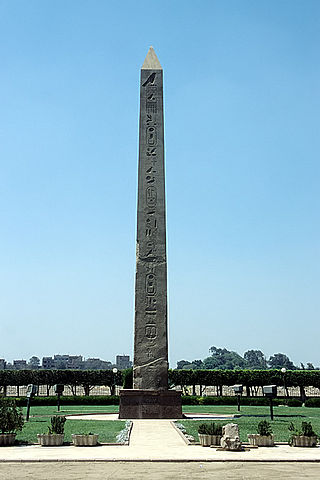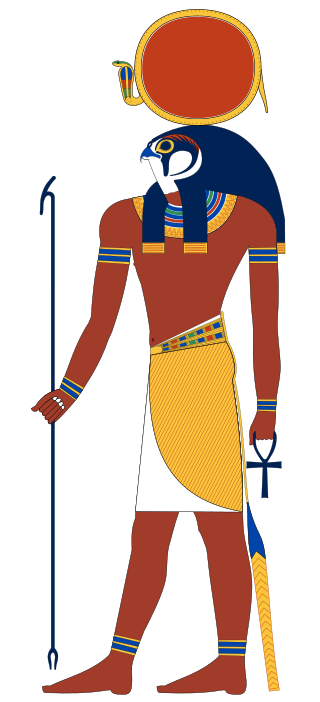
Ancient Egyptian religion was a complex system of polytheistic beliefs and rituals that formed an integral part of ancient Egyptian culture. It centered on the Egyptians' interactions with many deities believed to be present and in control of the world. About 1,500 deities are known. Rituals such as prayer and offerings were provided to the gods to gain their favor. Formal religious practice centered on the pharaohs, the rulers of Egypt, believed to possess divine powers by virtue of their positions. They acted as intermediaries between their people and the gods, and were obligated to sustain the gods through rituals and offerings so that they could maintain Ma'at, the order of the cosmos, and repel Isfet, which was chaos. The state dedicated enormous resources to religious rituals and to the construction of temples.

A solar deity or sun deity is a deity who represents the Sun or an aspect thereof. Such deities are usually associated with power and strength. Solar deities and Sun worship can be found throughout most of recorded history in various forms. The Sun is sometimes referred to by its Latin name Sol or by its Greek name Helios. The English word sun derives from Proto-Germanic *sunnǭ.

Aten, also Aton, Atonu, or Itn was the focus of Atenism, the religious system formally established in ancient Egypt by the late Eighteenth Dynasty pharaoh Akhenaten. Exact dating for the Eighteenth Dynasty is contested, though a general date range places the dynasty in the years 1550 to 1292 BCE. The worship of Aten and the coinciding rule of Akhenaten are major identifying characteristics of a period within the Eighteenth Dynasty referred to as the Amarna Period.

Akhenaten, also spelled Akhenaton or Echnaton, was an ancient Egyptian pharaoh reigning c. 1353–1336 or 1351–1334 BC, the tenth ruler of the Eighteenth Dynasty. Before the fifth year of his reign, he was known as Amenhotep IV.

Memphis, or Men-nefer, was the ancient capital of Inebu-hedj, the first nome of Lower Egypt that was known as mḥw ("North"). Its ruins are located in the vicinity of the present-day village of Mit Rahina, in markaz (county) Badrashin, Giza, Egypt.
Atum, sometimes rendered as Atem, Temu, or Tem, is the primordial God in Egyptian mythology from whom all else arose. He created himself and is the father of Shu and Tefnut, the divine couple, who are the ancestors of the other Egyptian deities. Atum is also closely associated with the evening sun. As a primordial god and as the evening sun, Atum has chthonic and underworld connections. Atum was relevant to the ancient Egyptians throughout most of Egypt's history. He is believed to have been present in ideology as early as predynastic times, becoming even more prevalent during the Old Kingdom and continuing to be worshiped through the Middle and New Kingdom, though he becomes overshadowed by Ra around this time.

Heliopolis was a major city of ancient Egypt. It was the capital of the 13th or Heliopolite Nome of Lower Egypt and a major religious centre. Its site is within the boundaries of Ain Shams and El Matareya, districts (kism) in northeastern Cairo.

Nu or Nun, in ancient Egyptian religion, is the personification of the primordial watery abyss which existed at the time of creation and from which the creator sun god Ra arose.

Amunet or Imnt is a primordial goddess in ancient Egyptian religion. Thebes was the center of her worship through the last dynasty, the Ptolemaic Kingdom, in 30 BCE. She is attested in the earliest known of Egyptian religious texts and, as was the custom, was paired with a counterpart who is entitled with the same name, but in the masculine, Amun. They were thought to have existed prior to the beginning of creation along with three other couples representing primeval concepts.

In ancient Egyptian religion, Apis or Hapis, alternatively spelled Hapi-ankh, was a sacred bull or multiple sacred bulls worshiped in the Memphis region, identified as the son of Hathor, a primary deity in the pantheon of ancient Egypt. Initially, he was assigned a significant role in her worship, being sacrificed and reborn. Later, Apis also served as an intermediary between humans and other powerful deities.

Hathor was a major goddess in ancient Egyptian religion who played a wide variety of roles. As a sky deity, she was the mother or consort of the sky god Horus and the sun god Ra, both of whom were connected with kingship, and thus she was the symbolic mother of their earthly representatives, the pharaohs. She was one of several goddesses who acted as the Eye of Ra, Ra's feminine counterpart, and in this form, she had a vengeful aspect that protected him from his enemies. Her beneficent side represented music, dance, joy, love, sexuality, and maternal care, and she acted as the consort of several male deities and the mother of their sons. These two aspects of the goddess exemplified the Egyptian conception of femininity. Hathor crossed boundaries between worlds, helping deceased souls in the transition to the afterlife.
Montu was a falcon-god of war in the ancient Egyptian religion, an embodiment of the conquering vitality of the pharaoh. He was particularly worshipped in Upper Egypt and in the district of Thebes.

Hesat is an ancient Egyptian goddess in the form of a cow. She was said to provide humanity with milk and in particular to suckle the pharaoh and several ancient Egyptian bull gods. In the Pyramid Texts she is said to be the mother of Anubis and of the deceased king. She was especially connected with Mnevis, the living bull god worshipped at Heliopolis, and the mothers of Mnevis bulls were buried in a cemetery dedicated to Hesat. In Ptolemaic times she was closely linked with the goddess Isis.

Atenism, also known as the Aten religion, the Amarna religion, the Amarna revolution, and the Amarna heresy, was a religion in ancient Egypt. It was founded by Akhenaten, a pharaoh who ruled the New Kingdom under the Eighteenth Dynasty. The religion is described as monotheistic or monolatristic, although some Egyptologists argue that it was actually henotheistic. Atenism was centered on the cult of Aten, a god depicted as the disc of the Sun. Aten was originally an aspect of Ra, Egypt's traditional solar deity, though he was later asserted by Akhenaten as being the superior of all deities.

Thuya was an Egyptian noblewoman and the mother of queen Tiye, and the wife of Yuya. She is the grandmother of Akhenaten, and great grandmother of Tutankhamun.

Egyptian sun temples were ancient Egyptian temples to the sun god Ra. The term has come to mostly designate the temples built by six or seven pharaohs of the Fifth Dynasty during the Old Kingdom period. However, sun temples would make a reappearance a thousand years later under Akhenaten in the New Kingdom with his building of the Karnak Temple in Thebes.
Amun was a major ancient Egyptian deity who appears as a member of the Hermopolitan Ogdoad. Amun was attested from the Old Kingdom together with his wife Amunet. His oracle in Siwa Oasis, located in Western Egypt near the Libyan Desert, remained the only oracle of Amun throughout. With the 11th Dynasty, Amun rose to the position of patron deity of Thebes by replacing Montu.

Ra or Re was the ancient Egyptian deity of the Sun. By the Fifth Dynasty, in the 25th and 24th centuries BC, he had become one of the most important gods in ancient Egyptian religion, identified primarily with the noon-day sun. Ra ruled in all parts of the created world: the sky, the Earth, and the underworld. He was believed to have ruled as the first pharaoh of Ancient Egypt. He was the god of the sun, order, kings and the sky.

Geb, also known as Ceb, was the Egyptian god of the Earth and a mythological member of the Ennead of Heliopolis. He could also be considered a father of snakes. It was believed in ancient Egypt that Geb's laughter created earthquakes and that he allowed crops to grow.

















